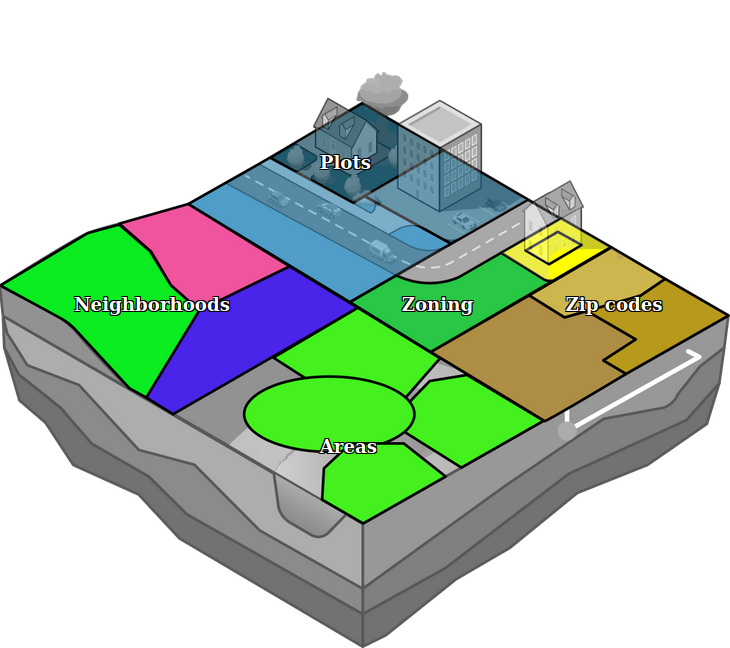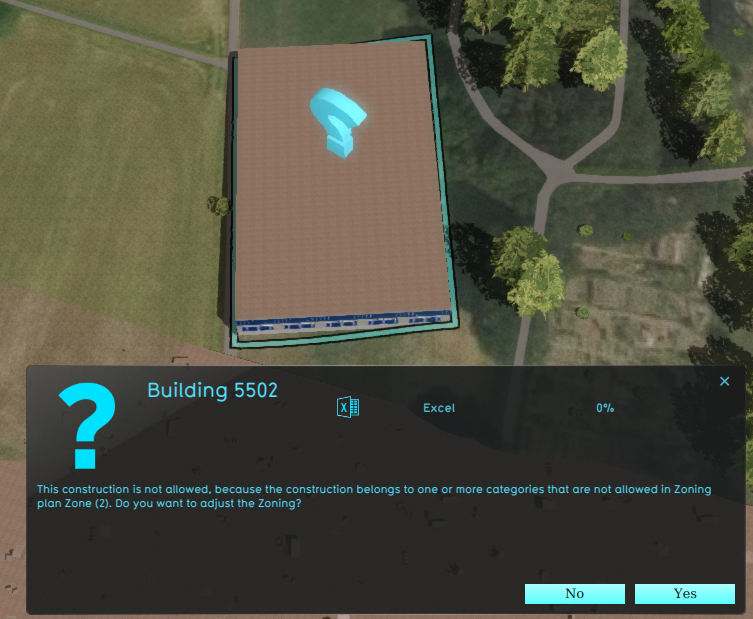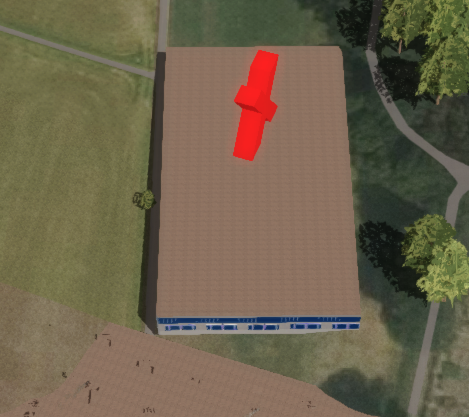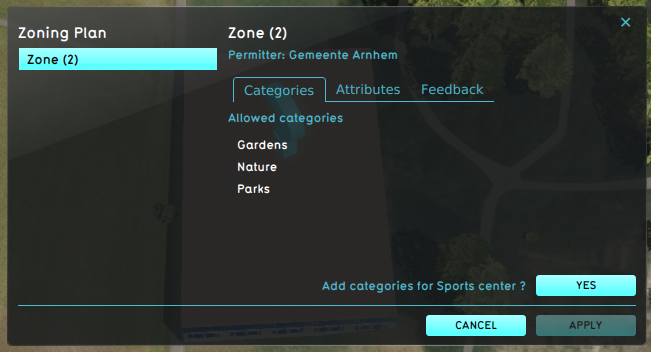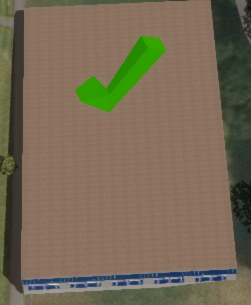|
|
| (78 intermediate revisions by 3 users not shown) |
| Line 1: |
Line 1: |
| {{learned|what zoning is in urban planning|how the concept of zoning relates to the Tygron Engine|how to add or remove zones from the 3D world|how to edit zoning already implemented in the 3D world}}
| | [[File:Api_current_situation_urban_subdiv.png|thumb|right|400px|[[Zone]]s in comparison to [[Area]]s, [[Neighborhood]]s and [[Plot]]s]] |
| | Zones in the {{software}} are spatial areas that can restrict, and provide feedback on, [[action]]s performed by [[stakeholder]]s. Each zone is assigned to a stakeholder; that stakeholder is the ''permitter''. |
|
| |
|
| ==What is Zoning?==
| | Zones can be grouped together to form a hierarchical zoning plan, each with specific requirements to which a new action must conform. |
| Zoning is a technique of land-use planning as a tool of urban planning used by local governments in most developed countries. The word is derived from the practice of designating mapped zones which regulate the use, form, design and compatibility of development. Legally, a zoning plan is usually enacted as a bye-law.
| |
|
| |
|
| There is a great variety of zoning types, some of which focus on regulating building form and the relation of [[constructions]] to the street with mixed-uses, known as form-based, and others with separating land uses, known as use-based.<br />
| | If, during a [[session]], an action does not conform to the zoning plan, a [[popup|permission popup]] will appear, indicating a conflict with the zoning plan. In order to resolve the conflict with the zoning plan, either: |
| [[File:zoning2.jpg|left|thumb|On the Zoning Scheme of the General Spatial Plan for the City of Skopje, different urban zoning is represented by different colors.]]<br clear=all> | | * the action has to be adjusted. |
| | * the zoning plan is changed by the permitter. |
| | * the action has to be reverted. |
|
| |
|
| ==Zoning in relation to the Tygron Engine==
| | Zones can determine if an action create a conflict with the current zoning plan in two ways: |
| In the Tygron Engine, zoning is an important element that can be used to guide the decision making process of the [[stakeholders]]. The stakeholder municipality has the responsibility to ensure the zoning plan is adhered to; each time a construction is planned by any of the stakeholders, the municipality has to verify if the plan complies with the zoning plan, prior to approval of the planned construction. To facilitate negotiations and bottom up participation, the municipality also has the power to change zoning plans. With this power, the municipality can offer other stakeholders approval for permits as trade off for complying with non zoning related objectives, such as less urban heat stress or more water storage in an area.
| | * A set of allowed [[Function Category|Function Categories]], used to verify planned [[Building]]s. |
| [[File:zoning14.jpg|thumb|left|200px|Zoning implemented in the Tygron Engine ([[Bedrijventerrein]])]]<br clear=all>
| | * An [[excel]] file. The excel file can request TQL statements to calculate a permittance score, determining whether a certain action can be permitted or not. Additionally, it can provide information on why that action was not permitted. |
|
| |
|
| When a [[function]] has been added to a zone in the Tygron Engine, they are added to the so called 'Zoning Plan'. This means stakeholders are allowed to create this construction inside this zone. They will still need permission from the Municipality to create this construction! When a function has not been added to the 'Zoning Plan' this means stakeholders are not allowed to create this type of constructions inside this zone. The municipality can still make an exception when the permission has been requested.
| | The project can also be configured to disable the permission popup, which will result in the following: |
| | * Actions will not be restricted by the zoning plan. |
| | * Potential conflicts with the zoning plan(s) are no longer calculated and reported to the stakeholders. |
| | However, zones can still be used in other calculated if needed, with feedback shown in custom-made [[panel]]s. |
|
| |
|
| ==How to add and remove zones in the 3D world==
| | An example of a Stakeholder placing a new Sports Center in a Zone that does not allow it: |
| When a new project is created using the [[wizard]], a zoning plan is automatically imported from [[data sources|available data]]. However, for empty projects, no zoning plan will exist by default, and zones will need to be added to make use of the zoning plan functionality.
| | <gallery heights=300px widths=300px> |
| | File:zoning_conflict.png|A zone reports a conflict with the planned [[building]], because its [[Function Category]] is not allowed. |
| | File:zoning_action_denied.png|Denying the action results in a message to revert the action. |
| | File:zoning_adjust.png|The permitter decides to adjust the zoning plan, using the [[Zoning permit panel]]. |
| | File:zoning_approves_action.png|The action now is in accordance with the zoning plan. |
| | </gallery> |
|
| |
|
| {{Editor ribbon|header=3D World|bar=Zoning}}
| |
| [[File:zoning-left.jpg|framed|left|The left panel allows you to add, remove and select zones.]]
| |
| New zones can be added to the project by opening the Zoning panel in the editor. In the left panel, a new zone can be added. To add a zone which does not restrict the categories of constructions allowed within it, select "Add Zone". To add a zone which does restrict the categories of constructions allowed, select "Add Zone With Categories". A new zone will appear in the list of zones.
| |
| ''Note that when a new zone is added, it is not yet present in the 3D world. Its contour must still be drawn in the [[3D world]] for it to apply.
| |
| Existing zones can be removed by selecting them, and then selecting "Remove".
| |
|
| |
|
| {{Editor steps|title=add zones to the 3D world|Open the Zoning panel|Select "Add".}} | | {{article end |
| {{Editor steps|title=remove zones from the 3D world|Open the Zoning panel|Select the zone you wish to remove.|Select "Remove"}}<br clear=all>
| | |howtos= |
| | * [[How to add and remove a Zone]] |
| | * [[How to edit Zone properties]] |
| | |seealso= |
| | * [[Zoning permit panel]] |
| | }} |
|
| |
|
| ==Changing a zone==
| | {{Template:Editor current situation nav}} |
| {{Editor ribbon|header=3D World|bar=Zoning|left panel=Zone}} | |
| [[File:zoning-right.jpg|framed|left|The right panel allows you to edit the properties of zones.]]
| |
| When a zone has been selected in the left panel, the properties of that zone can be edited in the right panel.
| |
| | |
| ====Name====
| |
| [[File:zoning-right-name.jpg|framed|right|The field for the "Name".]]
| |
| : ''The "Name" field is where the name of a zone can be changed. The name of a zone can be seen on the zoning [[overlay]]. By entering a new name in the "Name" field, the zone can be given a more identifying name.''<br clear=right>
| |
| | |
| ====Color====
| |
| [[File:zoning-right-color.jpg|framed|right|The selector for the "Color".]]
| |
| :''The color selector allows the zone color to be edited. The zone Color can be seen in the zoning [[overlay]]. The zone color is used for assigning different colors to different zones, to help users to distinguish the defined zones. By selecting the "Color" field, a new panel opens, in which a new identification color for the highlighted zone can be selected. ''<br clear=right>
| |
| | |
| ====Description====
| |
| [[File:zoning-right-description.jpg|framed|right|The field for the "Description".]]
| |
| :''The description field is for describing the selected zone. Here a short text describing the zone can be entered.''<br clear=right>
| |
| | |
| ====Floors====
| |
| [[File:zoning-right-floors.jpg|framed|right|The field for the "Floors".]]
| |
| : ''The floors field allows the maximum amount of floors to be set for the zone. This is commonly used to influence the skyline, population density and other urban planning issues. In a densely populated big city, having higher buildings helps creating living and working spaces for the inhabitants. In rural areas or outskirts, preservation of a more natural skyline might be desired.''<br clear=right>
| |
| | |
| ====Allowed zoning function types====
| |
| [[File:zoning-right-functions.jpg|framed|right|The list of function categories that can be allowed.]]
| |
| : ''Adding an allowed function category to a zone enables stakeholders to plan constructions of that category function inside the zone. To add a function category to a zone, check the checkbox next to the desired category. To disallow a function category, make sure the checkbox next to the desired category is unchecked.''<br clear=right>
| |
| | |
| ====Draw Area====
| |
| [[File:zoning-right-area.jpg|framed|right|The button to draw the zone.]]
| |
| :''The "Draw Area" button is used to assign an area in the 3D world to a specific zone. The assigned area can be seen on the zoning [[overlay]]. To assign an area in the 3D world to a zone, select the "Draw Area" button. This will open the [[brush|brush panel]] to assign an area to the selected zone.''
| |
| :''Please note that it is also possible to draw over a previously assigned zone.''
| |
